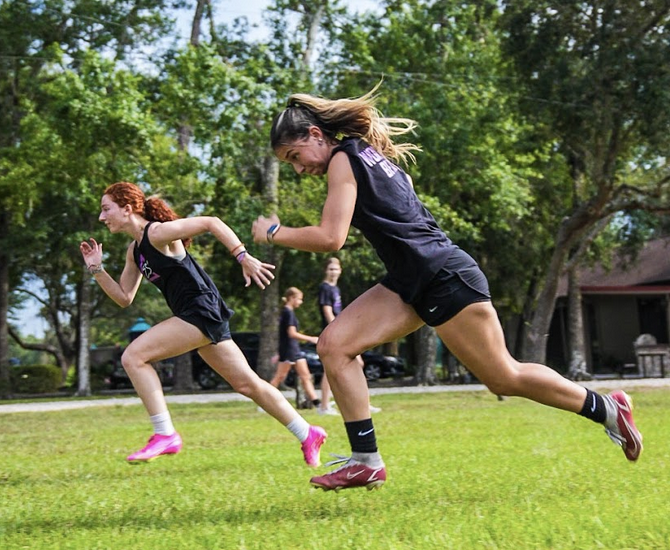Chase Health First, Soccer Performance Will Follow
Warning to girls soccer players: never sacrifice your health for performance.
Mary Cain, a pro mid-distance runner, was the fastest in the world at one point. In 2014, she won the 3,000-meter event at the Junior World Championships. She was on top of the world and one of the most successful up-and-coming young track athletes. Until…she was told she needed to lose weight to perform at an even higher level.
She took this to heart, and while her performance improved temporarily, eventually, her health declined, and her performance also declined.
Eventually, female athletes who take extreme, unhealthy measures to improve their performance lose.
The body will always keep score, and performance will reach eventually diminishing returns.

There’s only so much weight to lose and fat to trim until the body says back, ‘This is too much stress and malnutrition to handle.’ So, it manifests in girls losing their periods. Or suffering stress fractures. Or suffering muscle soreness for months. Or getting nagging injuries. Or losing energy and focus during games.
How about we change the narrative and have girls chase health first?
Because when health is the priority, sports performance follows.
Words Matter
Sadly, a lot of female athletes are told to lose weight by their coaches.
Body composition does impact performance, but girls’ soccer players are not educated on it in a healthy and empowering way.
They’re only told to “lose weight,” which is the worst advice since the number on the scale doesn’t tell the whole story about someone’s health and performance.
As a result, girls’ soccer players focus on trimming, burning, and cutting fat and losing weight. They’re fixated on the number on the scale.
The “lose weight” statement needs to be tossed in the trash, and we need to focus on building optimal body composition for each girl’s individual genetics, height, and body type.

Body Composition > Weight on the Scale
Instead of focusing on a meaningless number on the scale, girls’ soccer players should start focusing on building a robust body composition.
Body composition is the combination of muscle mass, bone (fat-free mass), and fat mass. It impacts performance because the stronger the muscles, bones, and ligaments, the stronger a girl’s soccer player is to handle the increasing demands of training and competition.

With fat mass, it’s important female athletes work toward a fat mass percentage that yes, keeps them explosive and supple and on the field, but not get a fat mass percentage too low, otherwise this hinders overall health. In fact, when female athletes under-eat and get too low in essential body fat, they are at risk for menstrual disorders as well as musculoskeletal injuries.
Girls must chase more muscle, strength, and strong and durable bones, and their joints, namely the knee and the itty bitty ACL ligament, will be much more protected.
Coming back to the “losing weight” comment, it doesn’t help female athletes focus on robustness.
We want to focus on adding, not subtracting, when it comes to body composition:
– Adding more protein to our meals
– Adding more healthy fats and Omega 3s
– Adding more carbohydrates rich in nutrients (fruits, veggies, raw honey)
– Adding more calories
– Adding more weights in the gym
– Adding more speed work
– Adding more muscle
– Adding recovery days so bodies can repair and build up
When we put the focus back on adding rather than subtracting, we empower female athletes to chase a body composition that improves both health and performance.

One last thing on the body composition front: every girl will have a different optimal fat-free mass and fat percentage. This depends on her body type, height, and genetics.
One girl may thrive at 16% body fat, while another may be her best at 18%. There is no universal ideal body composition for everyone. Always keep your eyes on your own paper.
Sign up for our Erica Suter Zoom Event on October 27, 2024: Female Athlete Growth and Maturation
Looks Are Deceiving
Just because someone is super thin doesn’t mean they’re the epitome of health.
Luckily, we have moved away from the days when magazine covers promoted super skinny. We sure have made progress, but we still don’t keep in mind that ALL looks are deceiving. Whether a body is skinny, in between, or obese, we have no clue what is going on internally.
It’s critical for female athletes to, yes, chase a robust and strong body composition, but they must check in with their internal health, too.
How can girls’ soccer players know they have a body composition that is healthy and high-performing?
Here are some subjective measures to check in on first:
- Menstrual: is it regular? Does your period come on time most of the time, and is it relatively pain-free? This is a vital sign of good female health.
- Mindset: is your mood stable most of the time?
- Muscle: are your weight room or performance numbers continuing to improve gradually over time, or have you declined in performance? Are you slowing down on the field?
- Motivation: Are you still motivated and excited to play soccer? Motivation gives us a clue if we are burned out.

Feelings are a good start to checking in on our health, but if there’s any lingering fatigue, headaches, PMS symptoms, or reoccurring injuries that shouldn’t be happening, then adolescent and college girls soccer players should consider having these labs ordered from their primary care physician:
- Full Metabolic Panel
- Vitamin D
- Vitamin B12 and Folate
- Iron and Ferritin
- C Reactive Protein
- Hemoglobin A1C
- Thyroid panel – TSH, T3 and T4
- Hormonal panel, Testosterone, Estrogen, Progesterone
When one or more of these are drastically out of range, then there are underlying health issues, namely, nutritional deficiencies, blood sugar issues, hormonal imbalances, and chronic inflammation.
When girls soccer players are deficient in nutrients or have hormonal imbalances, performance will suffer, whether it manifests as fatigue, slowing of speed and agility, less focus and awareness, bone injuries, or other soft tissue injuries.
We’ve had it backward for a long time, and many girls were chasing performance at the expense of their health.
Health First, Performance Follows
So try chasing health first. See what happens when you nourish your body, stay hydrated, eat nutrient-dense proteins, fuel without starving, strength train, and embrace muscle mass.
Now emboldened by your new training and nutrition habits, you’re at the pinnacle of your health. And because of this, your sports performance is at its apex, too.
Chase health first, and then your performance will follow.
Sign up for our Erica Suter Zoom Event on October 27, 2024 : Female Athlete Growth and Maturation
ABOUT THE AUTHOR

Erica Suter is a former college three-time All-American soccer player from Johns Hopkins University. She is now a full-time performance coach, giving back to the game and to female soccer players. She holds a Master of Science in Exercise Science and has been helping girls with speed, agility, strength, and conditioning for over 12 years in the ECNL, GA, and NPL.
Her players have gone on to play college soccer at UNC, the University of Maryland, Pittsburgh, the University of Southern California, the University of Detroit, Mercy, Northwestern, Eastern Carolina University, West Point, the University of South Florida, the University of Charleston, MIT, Johns Hopkins, Carnegie Mellon, Rutgers, Towson University, and more.
Get her book FEMALE ATHLETE HIGH PERFORMANCE
Follow Erica on Instagram: @fitsoccerqueen
Check out her podcast: The Soccer Queens Podcast
_
GIRLS SOCCER NETWORK: YOUR SOURCE FOR GIRLS SOCCER NEWS













